Planting a plant
At home, the coffee tree is planted in a deep pot, since the plant has a taproot that goes deep down. Before planting a seed of coffee, it must be scarified.
The coffee bean must be scratched deeply with a knife or lightly squeezed with pliers to crack the hard outer shell and it will germinate quickly. A coffee tree can be grown from seeds or from green cuttings.
Did you know? Scarification is a mechanical disruption of the seed coat. Without scarification, a hard grain (coffee, lagenaria seed, etc.) will lie in the soil until its outer hard shell decays over time.
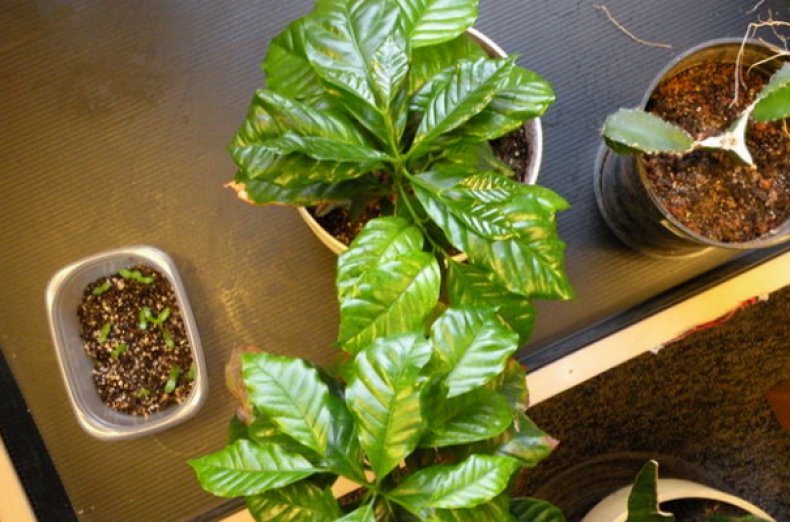
Seed reproduction
You can grow a coffee tree from purchased green coffee beans (not roasted). Before a coffee bean is soaked for germination, its shell is destroyed (scratched deeply).
Then they act in this order:
- a scarified coffee bean can be soaked overnight before planting in a growth stimulator (Epin, Emistim, Zircon);
- a deep pot is prepared for planting with a loose, slightly moist soil mixture and drainage at the bottom;
- the grains are planted in the ground to a depth of 3-4 cm (the distance between the planted grains is 3-5 cm);
- the soil with the planted coffee seeds is watered and covered with glass or a plastic bag;
- the pot is placed in a warm room: the higher the temperature, the faster the shoots will be;
- glass or film is removed from the pot twice a week, the condensate is shaken off and the crops are aired.
Important! The first shoots will appear in 50-55 days. Coffee is a tough plant, so the gardener will have to be patient .. Coffee seeds almost lose their germination after a year, their growth energy is determined as 3% out of 100
Therefore, if a florist has got hold of green dry coffee beans, then when soaking in stimulants and prolonged wet germination, 2-3 grains out of a hundred can hatch
Coffee seeds almost lose their germination after a year, their growth energy is determined as 3% out of 100. Therefore, if a grower got green dry coffee beans, then when soaked in stimulants and prolonged wet germination, 2-3 seeds out of a hundred can hatch.
It is much more likely to sprout a coffee seed from a neighbor's window tree. Such grain will be fresh, in a burgundy shell. The seed is visually split in two, and a separate coffee seedling will sprout from each half of the grain.
Cuttings
It is much easier to propagate a coffee plant with green cuttings. The soil mixture for planting the cuttings needs loose, with access to moisture and oxygen. For this, perlite and acidic bog peat crumb are mixed in equal proportions.
The soil in the pot is moistened with a light manganese solution - this contributes to the disinfection of the soil.
A branch for cutting is selected from an adult coffee tree in the middle of the crown. The twig should have four leaves. It is better to take a stalk from a branch of last year's growth. Such branches usually have bud buds, which means that the future tree will begin branching and flowering earlier.

The rooting stalk is cut from the mother tree with a sharp knife or blade. The cut is made three centimeters below the leaves. On freshly cut cuttings, under the last two leaves, longitudinal scratches are made on the skin with a needle (for better formation of future roots).
Next, the cuttings are placed in the root-forming liquid for three hours:
- a solution of honey and water (1 spoonful of honey in 1 glass of water);
- heteroauxin solution (1⁄4 tablet of the drug is taken for 1.5 liters of water).
In any of these root-forming solutions, cuttings are soaked only with the lower (scratched) part.To do this, they are placed vertically in a glass of liquid.
Prepared cuttings sit in the soil to the leaves. The planting depth of the cuttings is 2-3 cm. The pot with the planted cuttings is covered with a perforated plastic bag: through these holes, the seedlings will be ventilated and sprayed with water. Rooted cuttings shade from the sun.
For successful rooting, the most suitable temperature is + 25 ° C. The hotter and higher the humidity of the air, the faster the rooting takes place. Thirty degree heat is the maximum permissible temperature for rooted cuttings.

A sure sign that the cuttings have started is the growth of the upper buds. When a new pair of leaves grows on the handle, the plant can be transplanted into a separate container.
Cutting has several advantages over seed propagation:
- a young tree will have all the characteristics of the mother plant;
- the coffee stalk will bloom in the first year of planting;
- you can grow the first coffee fruits in a year.
Where to begin?
Naturally, the first step is to get a plant-like Arabica. And here there are three options - buy seeds and grow it yourself from scratch, buy a small sprout (or a large one, but more expensive) in a store, or take a cuttings from friends.
Each of these options has its advantages and what exactly to choose is a matter of individual preferences. Growing coffee from seeds is more interesting, but also more difficult, and even a novice florist can handle the cuttings.
Growing from seeds
Arabica seeds can be purchased at any specialty store. You can try to grow a tree even from green coffee beans, but this is quite difficult and unpredictable. The shell of coffee beans is very strong, and before planting, it must be cut or held in a special solution so that the sprouts can then germinate.
The seeds originally intended for planting, which are sold in the store, have already undergone the necessary processing, and the chance that they will later grow a coffee tree is much higher.
Sowing the seeds is in a mixture of peat and sand - this is one of the best combinations for such a plant. You can also add humus, sheet earth, charcoal - it will not be superfluous. After planting, the seeds should be watered with warm water, covered with glass on top and placed on the sunny side, but without direct exposure to rays. The ideal temperature regime for growth is 20-30 degrees. From time to time, future Arabica needs to be watered and a little growth stimulant can be added.
No more care is required yet, you just have to wait. It will take a very long time for coffee seeds to germinate - usually this process takes up to a month. Therefore, you should be patient and do not abandon your mini-plantation at home halfway. A tree grown from seed, as a rule, will begin to bear fruit in 3-4 years.
What to do with the handle
Everything is a little easier if you managed to get a stalk of coffee. In this case, you just need to put it in a jar with a small amount of water and wait until the roots appear. As soon as the root system becomes strong enough, the future tree can already be planted in a pot.
For rooting, a moist environment is needed, so the pot with the plant must be covered with polyethylene or a transparent cap, having previously made holes in them for air exchange. Spray and moisten the leaves through the same holes. Protect from sunlight, the light should be diffused, maintain the temperature at 25-27 ° C.
As soon as the tree takes root (the first two leaves appear), you can transplant the cutting and proceed to normal care. When transplanting, do not peel off all the peat from the roots, otherwise the plant may not tolerate the procedure well. Unlike the seed coffee tree, its flowering can already come in the first year of life, and the bush will grow in breadth and bush without exposing the trunk.
Ready sprout
And the easiest option is to buy a coffee tree in the store. The main thing here is to choose a healthy sprout, with strong shiny leaves, and at home immediately transplant the plant into a new pot. In the first two to three weeks, the tree, like the cutting, will require increased care - in particular, more frequent fertilization so that it can calmly survive the stress of transplanting.
If the stage of growing and rooting a flower was successful, further caring for the coffee tree at home should no longer be difficult. There are, of course, some features of plant maintenance, but they are quite simple and do not require a lot of effort and financial costs.
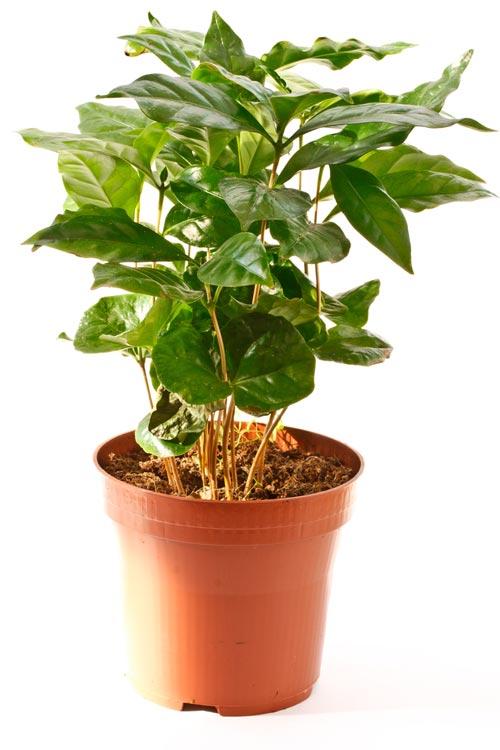
Caring for the coffee tree at home
One should not think that such an exotic plant for indoor conditions requires itself any special conditions. On the contrary, a coffee tree at home can give a hundred points ahead for the unpretentiousness of the same azalea, cyclamen, amaryllis and many other traditional indoor plants. But the rules of care, no matter how simple they are, must be observed.
Temperature
At normal room temperature, the coffee tree feels quite comfortable. But in winter, it is desirable for him to arrange a dormant period so that it can gain strength for the upcoming flowering and fruiting. It can withstand a rather significant drop in temperature (as for a houseplant). The lower redistribution of temperature is +12 degrees, but such an extreme is not necessary, it is enough to lower the temperature to +17 degrees. In most cases, this is the usual temperature on a windowsill in winter.
Lighting
Unlike the vast majority of indoor flowers, the coffee tree can also be grown in direct sunlight. Moreover, they are extremely necessary for him during the laying of inflorescences. But this only applies to mature trees. For young plants (up to two years old), such lighting is contraindicated. It should also be borne in mind that after the buds are laid, the coffee tree no longer needs so much light and it is desirable to slightly shade it. The lack of lighting is very bad for both the appearance of the plant and its flowering. For its placement, the best place will be the sill of windows oriented to the south (ideally southeast, southwest).

Watering, air humidity, feeding
During the warmer months, the coffee tree needs regular and abundant watering.
This is especially important if you have it on a warm, strongly lit place, where the earth dries out very quickly. Overdrying must not be allowed
Especially during flowering and fruiting! With the onset of cold weather and a decrease in temperature in the house, watering is reduced. It is impossible to allow waterlogging of the earth during this period!
Air humidity should always be high. In the summer, it is highly advisable to put the pot with the coffee tree on wet expanded clay or moss. But at the same time, try to regularly, once or even twice a day, thoroughly spray it. Spraying should be carried out only in the evening or morning, when the sun's rays do not illuminate the plant.
Hard water is not particularly suitable for irrigation and humidification. Rainwater in summer and snowy in winter is best.
The coffee tree is fed only during the period of activity (from April to September). For top dressing, liquid mineral fertilizer (complex) may well be suitable. The frequency of feeding is every 14-15 days.
Transfer
Up to three years old, a young coffee tree must be replanted every spring. Mature trees are somewhat less common - once every two to three years. In this case, the top layer of soil in the pot still needs to be changed every year.
The ground coffee tree loves sour. Although there are often cases when it grows successfully in ordinary garden soil, neutral. But if possible, try to buy the most suitable soil mixture for it (the package should indicate pH7). If you compose it yourself, then you can use this recipe:
- High moor peat (sour) - two parts (of the total volume);
- Leafy land (or garden) - one piece;
- Greenhouse land (compost can be used) - one part;
- Humus earth (well rotted) - one part;
- Sand or perlite - one piece
If possible, add pieces of sphagnum moss to the mixture, it will maintain moisture and slightly increase the acidity. Make sure to drain well.
If all these, by and large, fairly simple rules are followed, then the coffee tree at home will grow, bloom, and bear fruit, giving you joy and a harvest of wonderful coffee beans.
The coffee tree at home. Care.
After reading academic publications and listening to "wise" advice, many novice flower growers try to create special conditions for the coffee tree and read almost spells over them and lead round dances. Yes please! It won't hurt him in any way. But for successful development and growth, you need to follow only a few simple rules. Which, in fact, is the maintenance of the coffee tree.
Air humidity. It must be maintained constantly, while regular spraying may not be enough. It is best to put the pot on a pallet with pebbles or expanded clay and pour water into it. This does not exclude spraying!
Planting and transplanting. The soil for a homemade coffee tree should be acidic, i.e. pH -7. But I do not think that any novice florist (and not every experienced one) has the ability to determine the acidity of the soil. Therefore, the following soil composition is recommended for planting and transplanting a coffee tree (which is which, you can read here):
- Leafy ground - part 1
- Greenhouse land - part 1
- Humus earth - part 1
- Sour peat - 2 parts
- Sand - 1 part
And always good (!) Drainage. If possible, add chopped sphagnum moss to the mixture - it, among other things, will maintain acidity and preserve soil moisture. It is necessary to transplant a coffee tree before the age of three every year, after that - once every 2-3 years. But even in these intervals, it is desirable to change the topsoil annually.
P.S. In fairness, I must say that I know a couple of people whose coffee tree grows in ordinary, neutral soil. And quite successfully. Maybe they really do spells :).
Light for a coffee tree is also important, although this plant does not impose excessive demands on its lighting. South-facing windows (south, southeast, southwest) are considered the best place to place it.
On the north side, the coffee tree will also grow, but without enough light, its development will be inhibited and it will be difficult to achieve full flowering. Excess sun can also damage, but this is more true for young plants. Until the age of two, it is better not to allow sunlight to fall on them - this delays development. For adult plants, they are vital for obtaining full-fledged inflorescences. After their laying and fruit setting, light ceases to play such an important role and the plant can be shaded. By the way. In the homeland of coffee, where it is grown on open plantations, trees of other species are specially planted around each tree for shading. On our windowsills, you can see coffee trees under the rays of the scorching sun - and nothing ...
The temperature for a coffee tree is perfect for a normal room temperature. In winter, like many houseplants, it is desirable to create "winter conditions". The desired temperature is + 14-15 degrees, but it must be borne in mind that the lower limit is +12 degrees.
Watering and feeding. As for watering, its scheme is classic - plentiful in summer, moderate in winter. But! Consider the room temperature when determining how often you want to water.The ground near the coffee tree should be constantly moist (by analogy, for example, with an azalea), while avoiding excessive waterlogging or overdrying. It is better to water and spray with soft water. Rain or melt is well suited. You can fertilize the coffee tree during the period of active growth (April-September). It is better to do this with liquid mineral fertilizers every two weeks.
Important! The coffee tree really does not like permutations. Even a small turn, about 30-40 degrees, can provoke leaf shedding and stop flowering.
So be careful!
A good place for a coffee tree can be an office, an ordinary city apartment, or a child care center. If you follow these simple rules for caring for a coffee tree, it will successfully grow, bloom, and bear fruit. And on occasion, you can treat your guests to a cup of coffee from "your own plantation".
Tell your friends about the article and the site. Just press the buttons ...
Thanks!!!
How to care
The coffee tree is quite unpretentious to care for. Even a novice florist can grow an instance with bright greenery.
Important nuances that experienced flower growers pay attention to:
- Water and spray with filtered warm water.
- The air temperature should not be lower (+ 22 ° С), and the humidity should be 70–80%.
- Apply fertilizer twice a month.
- In the autumn-winter period, it is necessary to use ultraviolet lamps.
- In summer, it is advisable to take it out into the fresh air (in the garden, balcony, veranda).
- It is undesirable to move the flowerpot with the plant unnecessarily.
- Pruning is done as desired, so that the crown is thicker.
Location
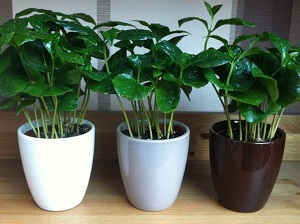
It is recommended to place the plant on the south side, a room with access to similar directions: southwest or southeast is also suitable. The north window will not give enough sunlight, you will have to illuminate with a lamp additionally. In summer, it is necessary to shade from direct sunlight so that there are no burns on the leaves.
Temperature
For good growth and fruiting, the plant needs: temperature + 22 ... + 25 ° С. In winter, the air should not cool down to + 12 ... + 13 ° С, this has a detrimental effect on the flower. If necessary, the ornamental plant is transferred to a heated room.
Lighting
The plant is light-loving. With a lack of lighting, an exotic tree does not bloom well, grows, bears fruit.
It is advisable to place the coffee tree in rooms where there is a lot of light: south or southeast. In summer, shade from exposure to direct sunlight.
If the windows face north, additional lighting is needed, otherwise the flower may wither due to lack of light. LED lamps or fluorescent lamps are used as artificial lighting.
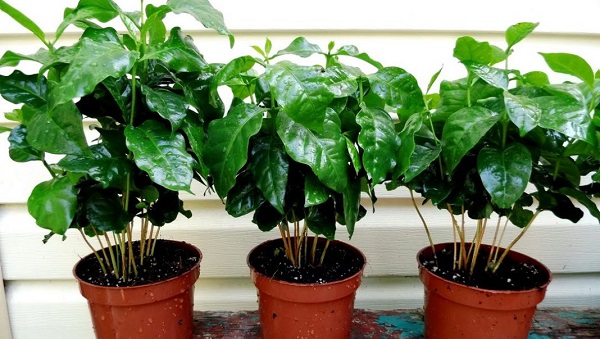
Watering and humidity
Important points:
- The coffee tree prefers high humidity and air temperature (+ 25 ° C).
- Watered and sprayed with settled warm water, in the spring-summer period they are guided by the dryness of the earthen coma.
- In winter, the substrate is moistened with an interval of three to four days, but the greens are irrigated every day.
- Water stagnation is not allowed so that the root system does not rot.
Fertilizers and feeding
For abundant flowering and fruiting, fertilizing with liquid fertilizers (mineral or organic) is performed.
In the summer, nutrition is necessarily enhanced: active growth occurs, flowers appear, fruits ripen.
The following are used as mineral fertilizers:
- nitrogen (ammonium sulfate, urea, sodium nitrate) - promotes the growth of stems and foliage;
- Potassium (potassium or potassium salt) - increases resistance to disease and increases the quality of buds and coffee beans;
- phosphorus (ammophos, superphosphate, diammophos) - strengthens the roots, improves flowering and fruiting.
Nitrogen fertilizers are used only in the spring, and phosphorus-potassium fertilizers - in the summer and autumn months. In winter, the plant is not recommended to be fed.
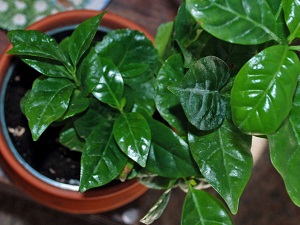
Organic dressings include:
- rotted compost (contains potassium, phosphorus and nitrogen);
- peat (replaces nitrogen);
- ash (analogue of potassium).
Nutrients are applied to wet soil in liquid form 1 time every 14 days. The best option is to use natural products and organics.
Pruning and shaping the crown
The plant forms the crown itself, pruning is needed only if the tree is too stretched upward. You can pinch the top branches to allow lateral stems to grow.
Transfer
The tree is transplanted after seed germination, the formation of roots in the cuttings, when there is little room for the plant in the pot (the roots are visible from the drainage holes).
Fundamental rules:
- prepare the soil;
- select the size of the flowerpot;
- drainage is laid at the bottom of the container;
- carefully remove the plant from the old pot;
- examine the root system;
- transferred to a new flowerpot, planting;
- watered with warm, soft water;
- it is enough to transplant an adult plant once every 3 years, and a young one every year.
Visual video - instructions for transplanting a coffee tree:
Reproduction
Features of the process:
- There are two proven methods: propagating an exotic tree using grains and cuttings.
- Take green seeds.
- If propagated by shoots, then it is necessary to cut off the stem with 4-6 leaves.
- Stimulate them with phytohormones, and additionally scarify the seeds.
- Plant the flat side of the grain in moist soil, deepen into the soil by 1 cm.
- The cutting is planted to a depth of 2 cm, greenhouse conditions are created: temperature - about +25 degrees, humidity - 70%.
- A month later, a sprout appears, and a sprout has new leaves and a formed root.
- The grown bush is transplanted into a new flowerpot.
Natural growing conditions of coffee trees
Ethiopia is originally considered the birthplace of coffee trees. The first trees of this species appeared there, from which all other varieties of Arabica originated. The Arabian variety has a different name for Arabica. Another interesting fact that confirms that the first trees appeared in Ethiopia is that any local resident can easily drink 12 cups of the strongest drink and still feel great after so much caffeine.
If a European, whose previous generations were not related to the alkaloid and were not used to it, drinks so much coffee, he will definitely go to the hospital with poisoning.
There is one difference: the Ethiopians used grains for food, and the Arabs learned how to make a drink from them.
There is also the Congolese tree or robusta. His homeland is also Africa, but this time the Congo. This tree is more common, as it has a strong immunity to diseases and environmental conditions.
Diseases and pests
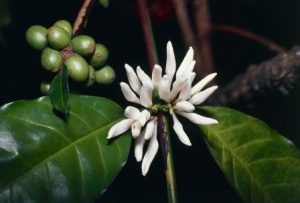
The coffee tree has strong immunity, but it can get sick due to improper care.
A weakened, “hungry” or overfed plant with mineral fertilizers can become the object of a successful attack of various infections.
The most common bacterial and fungal diseases of the coffee tree are:
Root rot - this disease affects plants with very high soil moisture
The coffee tree is a tropical plant that responds very well to frequent watering and high humidity, especially in the summer. But it is necessary to observe the measure, and not to allow strong waterlogging of the soil. Root rot is manifested by the wilting of the plant, the leaves acquire a brown hue, with a strong defeat of this disease, the coffee tree can completely die, therefore it is so important to immediately begin medical measures at the first signs of this disease. You can destroy the fungus using fungicides.
Good results in the fight against this disease can be obtained by shedding soil with Previkur.
Rust - like root rot, this disease is also fungal in nature.The leaves of a tree affected by this disease acquire a rusty coating, and if the fungus is not destroyed in time, the leaves begin to turn yellow and fall off. To save a tree from this scourge, it is necessary to immediately process the entire plant with antifungal drugs, for example, a solution of copper sulfate.
Bacterial leaf fall - the disease manifests itself, yellowing and leaf fall. At the first signs of damage to the coffee tree, the plant is treated with "Bordeaux liquid".
In addition to fungal and bacterial infections, coffee can be attacked by such pests of the coffee plant as:
- Scabbard - these insects, like aphids, suck sap from plant leaves. Naturally, such parasitism negatively affects the health of the coffee tree. Plants affected by this pest are delayed in growth, and the leaves, on which scale colonies are formed, dry out and fall off. Measures to combat this scourge are quite simple, a single treatment of the tree with any insecticidal preparation is enough and the pest completely dies.
- Red spider mite - this pest affects the coffee tree quite rarely, but if it has already settled, then you should get rid of it as quickly as possible, since this pest is very fertile, and can completely destroy the coffee tree in a couple of weeks. Such preparations as “Actellic”, “Appolo” and a very effective new generation drug “Skelto” cope well with the tick.
- Coffee weevil - This exotic pest lives mainly in warm, tropical climates, but can be imported with cocoa beans or coffee beans that have not been thermally processed. The pest damages the berries, inside of which the weevil larvae settle. If this pest appears on the plants, then the crop of the coffee tree, which is grown at home, can be completely destroyed.
The fight against the coffee weevil must be carried out at the first detection of this pest. From a weevil, you can use special chemical preparations, but a good effect is obtained by treating the plant with a decoction of wormwood.
Important! If the plant is treated with chemicals, then in a residential environment this can lead to poisoning and allergic reactions, therefore, precautions should be taken, rubber gloves and personal protective equipment should be used when working
Optimal plant conditions
It is not enough to plant the coffee tree correctly. In order for the seedling to take root and not die, it is necessary to create conditions for its maintenance.
These include:
- selection of a container of the required size;
- preparation of proper soil;
- providing the plant with sufficient lighting;
- the formation of the temperature regime.
Pot dimensions
The coffee tree will feel great in a small, cozy 350-450 ml pot. It is best for the seedling to choose a plastic light container with holes at the bottom through which air will flow and excess moisture will leave.
If you want to see ceramic bowls or bowls as a decor, then the choice should be given to shallow forms so that the roots can breathe. As the plant grows, gardeners recommend replanting the coffee tree in a plastic or wooden container.
The soil
Since the coffee tree is a heat-loving southern plant, it also needs a substrate that is close to the conditions of the tropics.
It is necessary to plant a coffee tree in the soil in proportions 2: 1: 1: 1: 1 of the following consistency:
- acidified peat:
- humus;
- drainage;
- garden soil;
- sand.
Lighting
Peculiarities:
- The coffee tree does not like bright direct sunlight. If you place the plant on a windowsill on the south side, then there is a high probability of burning glossy leaves.
- The plant needs to get enough light and without being darkened by a curtain.Therefore, it is good to place the coffee tree on the east side of the window.
Temperature
Coffee loves warmth and moisture, so the temperature regime for a young seedling is set as in a greenhouse - from 23º to 27º. When the seedling gets stronger, the temperature can be lowered to 22º-24º.
At the same time, it is still worth carefully observing the plant, since not all varieties of the coffee tree will positively perceive a decrease in temperature.
